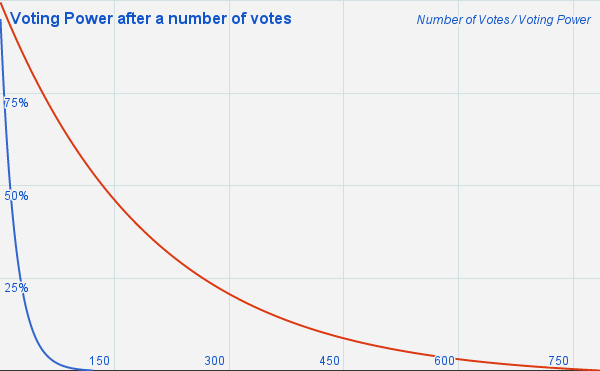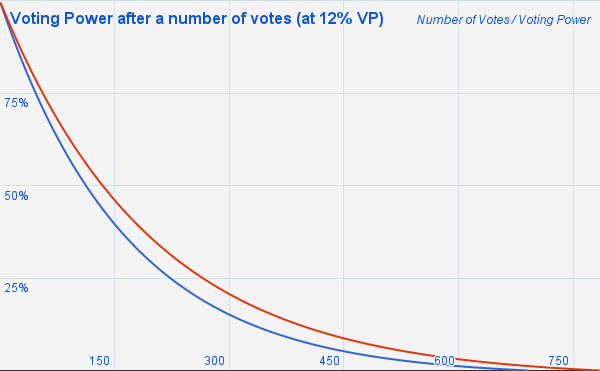What is the Target Votes 5 per Day change, anyway?
In the middle of the 0.14RC patch notes, one change caught my eye:
Target Votes of 5 per Day instead of 40
Since I've been studying and documenting this logic recently, I decided to go back to the source and check what was changed.
Looking back in my previous post, I wrote that:
Each vote decreases this value (exactly by how much in a bit), and it would regenerate from zero to full over the course of five days. In practice, you recover 20% voting power in one day or 0.833% in an hour.
And:
Now we have all the information to calculate the Reward Shares for our vote, like this:
Used Power = ((((Voting Power * Voting Percent) / 10000)) / 200) + 1
First, it determines how much of your VP you are spending on this vote. I'm not sure how the scaling factor 200 was chosen, but ultimately it's a linear correlation between them.
The change was to the factor of how much voting power is spent on each vote, while the voting regeneration speed is untouched.
The (Voting Power * Voting Percent) / 10000) factor is unchanged, so I'll call it Effective Voting Power. The amount of voting power used in a vote went from:
Used Power = (Effective Voting Power / 200) + 1
to
Used Power = (Effective Voting Power + 20 - 1) / 20
where the scaling factor was calculated to represent 1/4 of how much Voting Power would be regenerated in a day, which is 20.
Comparing the Power Spent per vote, before (red) and after (blue):

An interesting visualization is how your voting power gets spend after a certain amount of votes. Again, before (red) and after (blue):

Some observations: before this change, your voting power would drop to 79.81% when casting 44 votes, now it would drop to 81.41% after 4 votes, as expected. In the new model, it would drop below 1% after 86 votes, when it took 703 votes beforehand.
In both cases, it still regenerates 20% after a day and fully after five.
I'm wondering, though, can't bots just cast votes at a reduced weight to spend less voting power to mimic old behavior? Here's a comparison when casting votes at 12% at the new model:

In fact, at 10%, both lines overlap almost exactly. Maybe I'm missing something, but in effect that change seems to imply that new votes are the equivalent of voting ten times in a post in the previous model (and you can override it selecting the vote weight, if you can).
I think it's a bit too early to understand the impact of this change and whether it's positive or negative, or even if it's effective. Still, I think these kind of changes should be openly discussed more openly in the community before being implemented.
Does this mean that single votes will be worth more? By that I mean... if a user's 100% vote is worth $0.10 now.. will it be worth $1.00 after the fork?
Downvoting a post can decrease pending rewards and make it less visible. Common reasons:
Submit
In a vacuum, yes, it's roughly like you are casting 10 votes in a row. But since the amount of rewards generated per day is the same, it will tend to be more dilluted so maybe it's back to a lower value.
In truth I'm not sure - it depends on how the voting patterns change and I'd need to run a simulation on it.
Downvoting a post can decrease pending rewards and make it less visible. Common reasons:
Submit
The way I see it is that is would give the ability of someone to scale their normal votes to 10% to achieve the same effect under the new rules, but be able to selectivley powervote at 100% on stuff they really like.
I know others have posited on the cognitive overhead of the new system and whether this functionality is worth the extra thinking required to use it effectively and also wonder at the effect of this change.
Downvoting a post can decrease pending rewards and make it less visible. Common reasons:
Submit
I've read most of the comments in the original announcement post and think there are a lot of misconceptions. It's nice to read a post where somebody tries to understand what's really going on, so thank you for this.
I think one really important point not being discussed is the question of "how many votes does an average user cast per day?". Let's face it: a lot of users, probably most, don't understand the workings of the platform on a deep level, and just go with "what's easiest". Nothing wrong with that. I would also hazard a guess that on a statistical level, way too many people are close to 100% of the voting power most of the time. If this change lowers that number (and I think it probably will), the balance of power between bots and normal users is automatically shifted towards humans, like most users probably would like it to be.
For the minority reading this and the original post, not much is changed really, as you can just have things as they were by using the slider. Having said that, it would be nice to have a default setting for the upvote power, as fiddling around with the slider is extra work...
Downvoting a post can decrease pending rewards and make it less visible. Common reasons:
Submit
Well, I tried to answer something like that.
Downvoting a post can decrease pending rewards and make it less visible. Common reasons:
Submit
Thankyou for this analysis @burnin.
Having read through your analysis, would I be correct in saying that this change has little impact in real terms because larger accounts ( also known as whale accounts ) can simply reduce there voting power to 12% of its previous weight and continue to have almost the same effect on the voting system as they did in the past ? And if so do you think that whales voting with a reduced voting power of 12% (and I assume therefore whale voting will occur on more posts) will mean that more of the new or previously unnoticed steem posts will benefit from this change ?
Downvoting a post can decrease pending rewards and make it less visible. Common reasons:
Submit
Whales already vote with a reduced weight so that shouldn't change much. Maybe everyone will start voting at 10% and all will be the same.
More likely less votes will be cast and rewards will be more concentrated. Need to think more about it.
Downvoting a post can decrease pending rewards and make it less visible. Common reasons:
Submit
I think most likely people won't understand the change and be frightened from voting. But what you say at the end should be true: it shouldn't make a difference whether you vote a few times at full power or many times at reduced power. Actually, voting many times at full power should be exactly the same as voting many times at reduced power.
The other thing to remember about the change is that while you use up more power on each vote, your vote is also much more powerful.
Downvoting a post can decrease pending rewards and make it less visible. Common reasons:
Submit
I do agree people will cast less votes but I'm not sure rewards will be more concentrated. People most probably will still try to get the most reward from their curation and this isn't done with casting vote on the most votes posts.
Downvoting a post can decrease pending rewards and make it less visible. Common reasons:
Submit
People looking to maximize rewards from curation will likely vote with a reduced weight.
People voting on content they like will either vote less or have their votes matter less and less over time if they vote on more than 4 things a day (which sounds likely if one doesn't know the rules).
Downvoting a post can decrease pending rewards and make it less visible. Common reasons:
Submit
By the way, I found an error in your post: where you say
it should be
Used Power = (Effective Voting Power + 25 - 1) / 25.Because
dgpo.vote_regeneration_per_day = 5;and#define STEEMIT_VOTE_REGENERATION_SECONDS (5*60*60*24).5 times 5 is 25. :)
Downvoting a post can decrease pending rewards and make it less visible. Common reasons:
Submit
Ouch! Correct. Not sure why I thought it was 4.
The logic still stands, just slightly adjusted. ;)
Downvoting a post can decrease pending rewards and make it less visible. Common reasons:
Submit